Mark Sisson's Blog, page 299
May 21, 2014
Does Gluten Have Any Effect on Non-Celiacs?
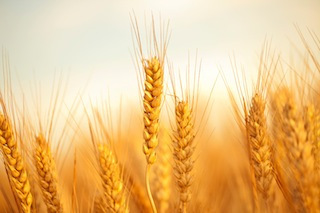 The headlines are everywhere: gluten sensitivity doesn’t actually exist, and anyone who thinks they have it is a liar, delusional, dumb, or all three. The message isn’t a new one, but the stories do point to a new study from a group of researchers who previously found that removing wheat from the diet improved symptoms in people with IBS. In the new paper, the researchers tested whether isolated gluten – rather than wheat – exacerbated IBS symptoms. It did not. The IBS patients in the latest study showed no reaction to isolated gluten, and the only dietary variable that increased their symptoms was wheat. This could suggest that at least for some people (with IBS), gluten sensitivity may actually be wheat sensitivity triggered by the fermentable FODMAP fibers found in the grain.
The headlines are everywhere: gluten sensitivity doesn’t actually exist, and anyone who thinks they have it is a liar, delusional, dumb, or all three. The message isn’t a new one, but the stories do point to a new study from a group of researchers who previously found that removing wheat from the diet improved symptoms in people with IBS. In the new paper, the researchers tested whether isolated gluten – rather than wheat – exacerbated IBS symptoms. It did not. The IBS patients in the latest study showed no reaction to isolated gluten, and the only dietary variable that increased their symptoms was wheat. This could suggest that at least for some people (with IBS), gluten sensitivity may actually be wheat sensitivity triggered by the fermentable FODMAP fibers found in the grain.
Folks are so eager to say “told ya so!” that they gloss over an important fact: going gluten-free still worked. Sure, I guess some IBS patients can start doing lines of isolated gluten powder or whatever, but if the FODMAP mechanism holds, they’re still not eating wheat. They’re still gluten-free, or wheat-free, or whatever you want to call it – and they’re still experiencing relief from debilitating symptoms.
The “why” is certainly important. It’s interesting. It provides jobs for researchers and fodder for online arguments. It can lead to effective treatments and pharmaceutical interventions. But it doesn’t affect the people, here today, dealing with health issues who cannot wait around for a consensus in the literature. They need results, and going gluten-free tends to work more often than not. And going gluten-free does not hurt as long as you don’t just replace gluten grains with gluten-free junk food.
But today’s post isn’t really about that.
People typically analyze gluten sensitivity through the prism of gastrointestinal distress. It’s often the first symptom we notice. It’s certainly the most obvious. If you don’t have celiac but eat some gluten and your stomach feels bubbly and the toilet becomes irresistible, you have non-celiac gluten sensitivity. If you can eat pizza without diarrhea, bloating, constipation, and/or inordinate amounts of gas, you probably don’t.
That’s how I know I’ve eaten gluten – my gut tells me. But for many people, there are extraintestinal, peripheral symptoms. And these aren’t just mass delusions. Legitimate research is discovering and beginning to unpack the connections between gluten, wheat, and a host of other disorders, even in the absence of celiac disease.
Those symptoms and disorders may still be mediated by the gut, but they’re not always felt in the gut. Kind of like how a tight muscle can affect other tissues along seemingly unrelated sections of the kinetic chain (ankle dysfunction can cause knee pain, for example).
The following are not ironclad, proven causal relationships. They describe correlations with plausible mechanisms, hypotheses still to be proven. I’m omitting any relationships purely based on anecdote, not to discount them, but to focus on the strongest candidates for conditions caused or exacerbated by gluten in non-celiacs.
Fibromyalgia
The mysterious, painful condition known as fibromyalgia has long been connected with celiac disease and general gut disturbances (IBS is quite common in fibromyalgia patients, for example, and IBS patients with fibromyalgia often have celiac). But only recently has non-celiac gluten sensitivity also been linked to fibromyalgia. Researchers selected 20 patients with fibromyalgia who experienced remission upon switching to a gluten-free diet, with remission including one or more of the following improvements: reduction in pain, return to work, return to normal life, or the discontinuation of painkillers. Tests confirmed they did not have celiac, leading the authors to suggest that “non-celiac gluten sensitivity may be an underlying case of FM syndrome.”
Autism
Gluten-free (often casein-free) diets are popular with many parents of kids on the autism spectrum, but most physicians have taken a skeptical stance on the whole premise. That’s to be expected. However, parents who report the strictest implementation of a gluten-free diet in their kids with autism report the largest improvements in symptoms. Oh, that’s just a large, admittedly well-documented and externally-verified compendium of anecdotes, you say? Recent research has shown that a subset of autistic kids show enhanced reactivity to gluten distinct from the response characteristic of celiac disease. You can certainly say that going gluten-free probably won’t help every kid with autism, but it looks like a portion of them are going to benefit from its removal.
(If there are any Spanish speakers in the house, check out this free full-text paper for a further look at the evidence. I’d be curious to hear what it has to say.)
Type 1 Diabetes
In pregnant mice who were diabetic but not celiac, a maternal gluten-free diet maintained during breastfeeding up until weaning reduced both inflammation and type 1 diabetes in the offspring. Pancreatic regulatory T-cells (which suppress inflammation) and tight junction activity were both up-regulated in the GF offspring. This echoes other rodent studies stretching back to the 1990s. Okay, but those are mice. They’re cute and mammalian and all, but what about human research? Most recently, a six year old with type 1 diabetes experienced remission upon adopting a gluten-free diet. Twenty months later, he was still off insulin therapy.
Schizophrenia
For nearly 50 years, a large body of research has tentatively established links between schizophrenia and wheat consumption. A 1966 study found that as wheat and rye consumption increased following World War 2, hospital admissions for schizophrenia also increased. Later that decade, the otherwise rare celiac disease was discovered to be oddly common among patients with schizophrenia, while early interventions saw some success at treating relapsed schizophrenia with grain-free diets. Abnormal sensitivity to gluten isn’t universal among patients, but there appears to be something there. And research continues to this day, with a recent meta-analysis finding that certain markers of gluten-sensitivity are elevated in schizophrenics compared to controls (and differently than in celiacs). Maternal gluten sensitivity is even related to the offspring’s chance of developing schizophrenia.
Depression
A recent case study found that a gluten-free diet led to remission of depression symptoms in a patient with non-celiac gluten sensitivity. A placebo-controlled trial from this year found that while isolated gluten added to a gluten-free diet did not cause GI distress (just like the study described in the introduction), it did increase symptoms of depression in a group of patients with “self-reported” non-celiac gluten sensitivity.
Ataxia
Not as well-known as some of the other conditions mentioned, ataxia is a neurological disorder characterized by an inability to control gait, balance, and hand-eye coordination. It’s incredibly serious, and multiple reports link it to gluten sensitivity. They even call a subset of it gluten ataxia, which is not accompanied by celiac-related enteropathy. A recent trial in patients with ataxia found that a gluten-free diet significantly improved symptoms, irrespective of GI symptoms.
Clearly, looking at the gut for evidence of non-celiac gluten sensitivity is not enough. And yes, it may very well turn out that it’s something else in the wheat causing the issues in these conditions, too, but does that change the effective therapy – a gluten-free/wheat-free diet?
No. It still works.
If any of these conditions affect you or someone close to you, a gluten-free diet may be worth trying. It’s free, after all.
Thanks for reading, all. For those of you with personal experience with any of these conditions, has going Primal – and gluten-free – helped at all? I’m really curious to hear.
Join Mark Sisson and Friends at the Mohonk Mountain House this June 5-8! Get Your Tickets for PrimalCon New York Today and Finally Meet Your Tribe!




May 20, 2014
Self-Experiment: No Alcohol for 45 Days and Counting
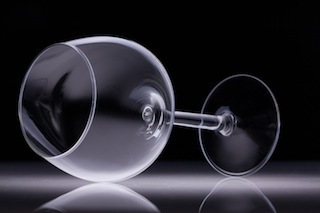 I’ve always had gut issues – IBS and related challenges. In fact, the diarrhea, bloating, gut pain, gas, and the assorted other embarrassing IBS symptoms that make life truly difficult are what led me to this lifestyle. Getting rid of grains at age 47 was life-changing, and even as gluten deniers are becoming more vocal I will adamantly stand by that shift as one of the most important Primal behaviors anyone can adopt. I went from waking up everyday in pain most of my life, having to be continuously aware that an episode might occur at any time, and planning my daily excursions away from home based on where I knew there might be a (satisfactory) public bathroom, to feeling freedom from that cramping and pain, and being able to travel without trepidation. Adding probiotics like Primal Flora helped “regulate” me even more.
I’ve always had gut issues – IBS and related challenges. In fact, the diarrhea, bloating, gut pain, gas, and the assorted other embarrassing IBS symptoms that make life truly difficult are what led me to this lifestyle. Getting rid of grains at age 47 was life-changing, and even as gluten deniers are becoming more vocal I will adamantly stand by that shift as one of the most important Primal behaviors anyone can adopt. I went from waking up everyday in pain most of my life, having to be continuously aware that an episode might occur at any time, and planning my daily excursions away from home based on where I knew there might be a (satisfactory) public bathroom, to feeling freedom from that cramping and pain, and being able to travel without trepidation. Adding probiotics like Primal Flora helped “regulate” me even more.
But even up to a few months ago I still would notice the occasional gut issues arising once in a while, mostly just in the morning, and mostly fully resolved after going to the bathroom a few times. So, as comfortable as I felt 98% of the time, I still wondered why that would happen at all, if in fact I had done everything I needed to do to fully “heal” my gut, or to at least unburden myself from any further severe gut pains.
For a while, I thought it might be lingering stress that was causing these irregular bouts of intestinal distress. I have often shared here how I don’t think I handle stress that well (even though I know a ton about the deleterious effects of stress – maybe I worry too much about worrying). It’s often said that people carry their stress in their gut, so that made sense to me on some level. And since research shows that psychological stress has directly deleterious effects on the gut itself, there was scientific plausibility. One of the reasons I decided to drink a glass or two of wine each night was to wind down after a stressful day. And that seemed to work very well for me. I came to cherish that end of the day routine, the pop of a cork, the click of the glasses, the quiet hour or two spent with Carrie winding down the day and sipping together. I swear I could feel the stress leaving my body.
My justification for drinking what amounts to a poison was that maybe the stress-reducing effects of wine outweigh the negative consequences of ethanol for some people. I assumed it was the case for me. But then there was always that little voice asking if I’d done everything to address this lingering gut issue, and maybe there was a connection between ethanol and gut health.
So I decided to look.
Obviously, a binge is bad. Recent research shows that it’s bad for our guts. Acute bouts of moderate-to-high dose ethanol administration (4-5 drinks in a short period of time, or whatever it took to raise subjects’ blood alcohol concentration to 0.08 in an hour) increase intestinal permeability and allow endotoxins to slip into the bloodstream to causes systemic inflammation. (Of course, there’s no mention of food intake. If the subjects drank vodka on an empty stomach, the results may not be applicable to someone having four glasses of wine with their meal. Alcohol absorption and toxicity increase rapidly on an empty stomach, and I’m not drinking like that. I take my wine with my meal, or after.)
But what if even moderate alcohol consumption – the “healthy” way that I’ve been doing for years – could affect the gut negatively?
Well…
There’s physiological precedent. Ethanol directly increases permeability in epithelial cells. So when you drink a glass of wine (or scotch, or vodka) and expose your gut to ethanol, tight junction leakiness increases. Plus, just like our livers metabolize alcohol into the extremely toxic acetaldehyde, gut bacteria themselves metabolize alcohol into acetaldehyde. This can also cause tight junctions to grow more leaky.
There’s clinical precedent. Moderate wine consumption (1-3 glasses a day) caused relapse and increased leaky gut in patients with inactive inflammatory bowel disease (IBD). That wasn’t me – I “just” had IBS – but it’s relevant because a small amount of wine consumed regularly was enough to hamper recovery.
Moderate (1 drink per day for women, 2 for men) is also associated with small intestinal bacterial overgrowth, a common cause of gastrointestinal issues like bloating, gas, pain, diarrhea, and constipation. Meanwhile, another study out of Spain found that moderate red wine drinking led to increased levels of beneficial gut bacteria. It seems contradictory, but red wine contains polyphenols which can act as prebiotics for gut flora, whereas the first study failed to distinguish between different types of alcohol. “Alcohol” could have been a shot of gin, a can of PBR, or a thimble of moonshine.
There was evidence that alcohol could have negative effects on the gut, albeit in other people. It was time to experiment on myself.
So I dropped alcohol entirely. No wine at night, even after a stressful day. That was 45 days ago. I’ve only had a couple glasses of wine here and there as challenges to test my progress and see what’s changed.
What have I noticed?
I have a theory that once we clean up our act by going Primal, once we’ve gotten great results by sticking to the plan, we then sometimes try to “see what we can get away with” in terms of reintroducing non-Primal fare. This is totally normal, and I do it too. In my case, I know that I don’t store fat easily, so I can get away with eating more safe starches or fruit than most people. I generally don’t do that, but I know I could anytime I wanted. On the other hand, I know that anything with gluten will rear its ugly head if I do too much. I know where the line is (say, two small bites of fresh sourdough bread slathered in butter on a restaurant plate, but not four) and yet I sometimes still see what I can get away with. Maybe it’s a eating a little chili with beans, some edamame at a sushi restaurant or a handful of peanuts. I know my limits.
I suspect that there was something more than hormetic about my consumption of ethanol combined with whatever normal gut challenges I might allow myself on those occasions, such as a little bread here or there or an increased legume intake. Rather than being an acute stressor that promoted a stronger compensatory recovery, I suspect daily wine was having an additive effect on the integrity of my gut which, over time, prevented complete recovery. This constant moderate exposure to a toxin that’s already hard on the gut made those intermittent challenges (the sourdough, the beans, a particularly stressful day or hard workout) to the gut’s integrity even more damaging.
Since I’ve been on this experiment about six weeks, I do feel as if I’ve reached a new level in gut comfort. My gut issues, although almost entirely resolved on Primal, have become nonexistent. When I challenge myself with a gut-irritant like bread, my discomfort threshold is higher. And I’m figuring out other ways to deal with end of day stress that don’t involve alcohol. Who knew that you could mimic the other aspects of the ritual – relaxing with your significant other after a great meal and talking about your day – and get the same benefits without opening a bottle of Zin?
I’ve noticed other changes, too.
With two glasses of red wine at night (say, from 6-7:30 pm), I’ll fall asleep easily when it’s bedtime, but often wake up at 2 or 3 am and have a tough time going back to sleep. Without wine (or with a small single glass early) this past month and a half, I’ve generally been sleeping comfortably through the night.
Now, I’m not anti-alcohol. There’s a time and a place, the good and the bad, and many people can enjoy it without incurring major negative effects. But I do think we in the ancestral health community tend to give it too free a free pass. We use a few cursory references about polyphenols, maybe an observational study or two on mortality and alcohol intake, and throw in the word “hormesis” and leave it at that. So today, I’m suggesting that you guys give an alcohol-free trial run just to see if you notice any improvements. It’s tinkering on the margins of health, but sometimes the margins hold the most promise for the otherwise healthy.
Because until we do give it up, we won’t know. Remember how you felt about grains and sugar and vegetable oils before you got into Primal – how you “felt fine” until you removed them and realized you had been suffering all along?
So I’m pretty sure I won’t go back to two glasses a night from here. I’ll likely do one glass a few times a week and maybe two glasses on special occasions.
Let’s hear from you guys. Have you ever given up alcohol or noticed an interaction with the integrity of your gut? Will you try a no-alcohol experiment?
Thanks for reading!
Join Mark Sisson and Friends at the Mohonk Mountain House this June 5-8! Get Your Tickets for PrimalCon New York Today and Finally Meet Your Tribe!




May 19, 2014
Dear Mark: Are My Vibram FiveFingers Dangerous?
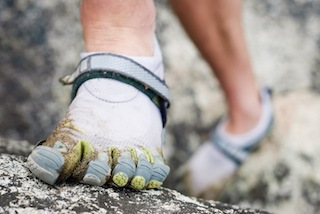 Today, I’m answering one hot-topic question for this week’s Dear Mark. It concerns an issue that’s inspired several dozen emails from readers: the Vibram FiveFingers lawsuit and settlement. If you want to skip ahead to the take home point, it’s that I’m not getting rid of my Vibram FiveFingers anytime soon. Heck, I’m wearing a pair as I type this. I may even be typing with my FiveFinger-clad toes. (It could happen…) If you want my more extensive take on it, read on.
Today, I’m answering one hot-topic question for this week’s Dear Mark. It concerns an issue that’s inspired several dozen emails from readers: the Vibram FiveFingers lawsuit and settlement. If you want to skip ahead to the take home point, it’s that I’m not getting rid of my Vibram FiveFingers anytime soon. Heck, I’m wearing a pair as I type this. I may even be typing with my FiveFinger-clad toes. (It could happen…) If you want my more extensive take on it, read on.
Mark,
I would love to hear your comments on the FiveFingers lawsuit. I suspect many of your readers and listeners would be interested too. Possible blog post or podcast topic?
It seems to me that the “science” used to drive the lawsuit was a bit questionable. Is this real, or just a shakedown for money?
George
Sorry, George. Reading the Deadspin link makes it pretty clear. Any benefits you thought you had experienced since donning the FiveFingers are just that: a thought, a flight of fancy conjured up from your brain in an attempt to justify the hundreds of dollars spent on a faulty product. Your knee does hurt. That’s not your shoelace you keep stepping on. It’s your Achilles tendon dangling uselessly like a five year-old rubber band.
In fact, I’d wager that this Vibram lawsuit will whisk away the veil of collective placebo currently conning millions of Vibram-wearing readers across the globe. The knee pain that’s actually always been simmering beneath your consciousness held at bay by delusion will pick back up any minute now. Your false foot musculature will begin atrophying presently. The sheer raw joy of feeling the cracks and stones and leaves of grass beneath your minimally-clad feet will turn to ash and blunt numbness. They were all a dream. You were tricked and bamboozled. Thanks for playing. The honeymoon is over. The bone marrow edema is coming. Fluid pools accumulate and drown you. Time to die.
Jokes aside, what’s this Vibram lawsuit saying, anyway?
Ignore the astute thinkers in comment sections. Vibram isn’t being sued for making shoes that hurt your feet. Vibram is being sued for making unsupported claims that using FiveFingers could reduce foot injuries and improve the strength of foot musculature. That’s it. Nothing else.
To win the case (or get the company to settle), the plaintiff doesn’t even have to prove that these claims are false and that the opposite is true (the shoes cause damage). They just have to prove that the claims are not supported by the available evidence. And for the most part, that’s true. They aren’t.
Anecdotes on message boards (however true) aren’t admissible in court. Appeals to the evolution of human biomechanics (however valid) will fall on deaf ears. Clinical research is required to prove a benefit, and what little research exists is ambivalent, showing mixed results.
This isn’t a conviction of minimalist footwear, as I’ve mentioned previously. Clinical trials on minimalist running are notoriously difficult to do properly. The transition period from regular shoes to minimalist shoes alone requires far more than the dozen or so weeks most studies lend it. This makes the few trials we have to go on fatally flawed, but not useless. They show what not to do. They suggest that the importance of the transition should not be understated or taken lightly.
It may seem like a “no true Scotsman” defense. But it’s true. Running in minimalist shoes takes a lot of preparation, training, and skill – especially if you’ve worn Nike-branded casts on your feet for years – and I don’t think the studies we’ve seen up until now demonstrate sufficient preparation. It’s like when you broke your arm as a kid and sat in a cast for ten weeks. Remember when they finally took it off with that weirdly discriminating saw blade and your arm smelled funny and looked really small and skinny? Remember how you tried to sign your name in class and it felt like you had to learn how to write all over again? Remember how useless Han Solo was when Leia snuck into Jabba’s palace to dissolve the carbonite he’d been stuck inside for months?
That’s what trying to use your feet after a lifetime of keeping them encased in leather and raised rubber is like. You have to learn all over again. Your feet are to shoes as Han Solo is to carbonite.
And “experienced” runners – often the subjects of these minimalist running studies – switching over have it even harder, believe it or not. They’ve been running one way in one type of shoe for many hundreds of miles. Their feet have molded themselves to run in the shoes. Their unused muscles have atrophied. Their neuromuscular circuitry is wired for protective shoes. You can’t undo that in a few weeks. You can’t just switch over and continue to log the same amount of miles. Heck, you may not even be able to log a fifth of the miles you were doing. You probably shouldn’t do anything but walk to start.
“Land on the balls of your feet,” they say. Just take off your shoes and let instinct take over. A forefoot landing is important, but it’s not everything. It’s not enough. A lot of beginning minimalist runners misinterpret the “forefoot landing” advice. You’ll see them around town, bouncing up and down on their toes, prancing along. This is very wrong. It’s not enough to merely land on the midfoot/forefoot. You have to gliiiide. Your head should remain fairly stable with minimal vertical movement.
Which tissues are most impacted by bouncing up and down on your toes? Your calves and feet. Look, try it. Take your shoes off and bounce in place from left foot to right. Get some air. Land on your toes. Do it for a minute. How do you feel? It’s no wonder that foot and calf issues are probably the most common injuries in new Vibram users.
So I’m not surprised that Vibram wearers showed increased levels of bone marrow edema, a marker of inflammation and harbinger of fracture, in the recent study (PDF) that often accompanied the lawsuit reports.
Reports of the study make it sound like the authors set out to reveal the danger posed by VFFs. Reports make it sound like they were successful in this non-existent quest. Really, study authors were just exploring the phenomenon of new minimalist runners hurting themselves during the transition. They conclude not that “runners interested in transitioning to minimalist running shoes should stick to their old shoes” but that “runners interested in transitioning to minimalist running shoes… should transition very slowly and gradually in order to avoid potential stress injury in the foot.”
I totally agree with them. Don’t you?
Running for extended periods of time at a fast pace is inherently dangerous. I’m sorry. It is. It can make you incredibly fit and fast, but running as a voluntary, daily, constant behavior is problematic. I’ve always said that traditional shoes mask the damage running does to our bodies. Going barefoot or minimalist reveals it. VFFs reveal your weaknesses, your technique deficiencies. They make you realize how dangerous running can be if you do it wrong.
That they lay bare the ramifications of chronic cardio is one of the main benefits (although some may not see it that way) of minimalist/barefoot shoes. They enhance the feedback we get from the environment. If we’re hurting ourselves, we feel it. If we’re placing too much stress on on our feet, calves, or Achilles tendons, we know it.
Running incorrectly in minimalist shoes is harder on your body than running incorrectly in padded shoes. Heel striking in minimalist shoes is harder on your body than heel striking in padded shoes. There’s far less room for error. That’s why they’re such powerful tools, but it’s also why short-term studies in longterm running shoe-wearers show mixed results.
Whenever I write about barefooting or minimalist footwear, I end up repeating myself. But the same criticisms keep appearing in the media, and I always get emails about them from worried readers, so I’m going to keep at it:
Your transition into minimalist footwear should take longer than you think. The group of experienced runners in the study took ten weeks to do it, slowly adding in mileage in the Vibrams a mile at a time the first two weeks, then as much as they felt comfortable running, and a bunch of them developed evidence of early bone damage. Ten weeks wasn’t enough.
Don’t run the first week. Not even a little bit. You’re not ready. Even if you feel ready, you’re probably not. Bones and connective tissue take a lot longer to adapt to stress than muscles. The runners in the study felt fine running and it turns out they weren’t.
Running shouldn’t be jarring or bouncy. Glide forward, don’t bob up and down. Don’t run for distance until you grasp this.
Consider just being barefoot or minimalist. Walk, hike, squat, jump, climb, play, stand. You don’t have to run to get the benefits.
Be smart about it. If you get weird pain, stop doing it. If you feel a funny twinge in your Achille’s tendon, stop. If your calves are killing you from finally doing something with them, maybe just walk the next couple days until the DOMS subsides.
Yeah, you may have read similar stuff from me before, but that person who just stumbled on this page searching for “Vibram lawsuit” probably hasn’t. And he or she may actually try those weird looking shoes the right way, with due diligence, rather than blunder into a foot injury from overzealousness or listen to the naysayers and avoid a way of locomotion that can potentially revitalize their body.
Thanks for reading, all. Take care.
Not a Subscriber? You Are Missing Out. Subscribe for Free Today and Instantly Get 8 Primal eBooks and So Much More!




May 18, 2014
Weekend Link Love
 Episode #19 of The Primal Blueprint Podcast is now live and it features a very special guest: Steve Wright, the leaky gut guy. If you have leaky gut – or think you might – and want to fix it, this podcast is for you.
Episode #19 of The Primal Blueprint Podcast is now live and it features a very special guest: Steve Wright, the leaky gut guy. If you have leaky gut – or think you might – and want to fix it, this podcast is for you.
Speaking of Steve, his excellent Solving Leaky Gut will help you figure out how to fix your gut, improve digestion, and reduce food sensitivities. The deal ends on the 19th (that’s tomorrow), so act fast!
Research of the Week
But I thought a calorie was a calorie was a calorie.
We might not remember things that happened to us as babies because the birth of new brain cells literally erases the memories.
33% of the supposedly non-toxic ingredients in personal care products “significantly affected the potency of human sperm cells” in a new study. Something to think about when you’re slathering up your nether regions.
Amazing crow science that has nothing to do with health or nutrition but remains relevant to this site because wonder is Primal: New Caledonian crows understand water displacement about as well as a 7-year old child.
Roundup-ready soybeans are particularly good at accumulating the herbicide glyphosate.
Interesting Blog Posts
The secret to getting the perfectly peeled hard boiled egg.
It turns out that the California Dietetic Association’s annual convention is catered (and sponsored) by McDonald’s.
A nice take on that protein overfeeding study by Dr. Bill Lagakos.
Media, Schmedia
By now, you’ve probably heard about the Vibram Fivefingers settlement. If you have a pair, are you seeking redress? This guy isn’t. Neither am I.
A new documentary called “Fed Up” asks if all calories are indeed treated equally by the body.
Everything Else
Thomas Edison, a “staunch opponent of sleep,” was kind of crazy.
Sifting through the wheat and chaff of gluten cross-reactivity claims.
The mud pits used in Tough Mudder races might contain more than just mud.
This pic of a single drop of seawater magnified 25 times is just incredible.
Recipe Corner
Even if you don’t actually make this dish of poached eggs in a spicy red meat sauce, it’s oddly soothing to say the word “shakshouka.”
Don’t ask what “mulligatawny” means. Just make the stew and eat it.
Time Capsule
One year ago (May 18 – May 24)
Raising Your Kids on Primal Foods (plus Mealtime Strategies for Picky Eaters) - How to get your kids (or any fussy adults in the family) off on the right track eating Primal.
5 Helpful Analogies for Understanding Complex Health Issues - For answering questions about your crazy lifestyle – or for your own edification.
Comment of the Week
Also, I know that Mark is friends with Tony Horton. Perhaps Mark can chime in with a comment on where he feels Tony might rate on the “nearly human-like humanoid partner” scale…
- No comment, Michael!
Get the 7-Day Course on the Primal Blueprint Fundamentals for Lifelong Health Delivered to Your Inbox for FREE




May 17, 2014
How to Hot Smoke Salmon (Without a Real Smoker)
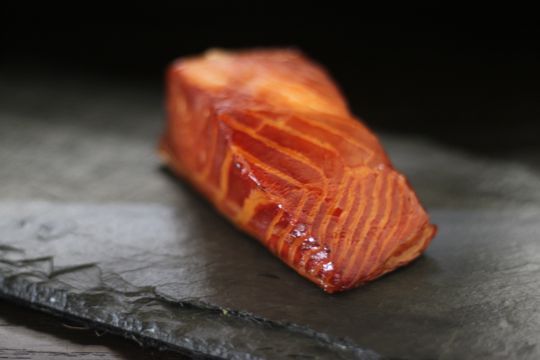 If you love hot smoked salmon but don’t own a smoker, then this recipe for hot smoked salmon is for you. This method involves rigging up a smoker in your kitchen (on a gas stove) using wood chips, aluminum foil, a round cake rack and a wok. The salmon that emerges has a big, bold smoky flavor with a little bit of a sweet-salty thing going on too.
If you love hot smoked salmon but don’t own a smoker, then this recipe for hot smoked salmon is for you. This method involves rigging up a smoker in your kitchen (on a gas stove) using wood chips, aluminum foil, a round cake rack and a wok. The salmon that emerges has a big, bold smoky flavor with a little bit of a sweet-salty thing going on too.
The texture of salmon hot smoked this way, rather than in a real smoker, is moister and less flakey (expect the middle to look similar to what a fillet of regular cooked salmon looks like). So, it’s not exactly the same thing, but if you love a smoked flavor then you’ll love this salmon in its own right.
While you’ll be tempted to eat it right out of the smoker, hot smoked salmon tastes best when chilled. Served over a bed of greens, it makes a killer salad. The recipe specifies wild salmon, and by now most of you know exactly why: wild salmon has more healthy omega-3 fats and far fewer toxins than farmed salmon.
This method of smoking won’t send smoke billowing through your house; no need to pull the batteries out of the smoke detectors. But it will make your house and wok smell pleasantly smoky in a sitting-around-the-campfire kind of way for the next day or so.
Servings: 4
Time in the Kitchen: 16 to 24 hours for brining and drying, plus about 20 minutes to smoke
Ingredients:
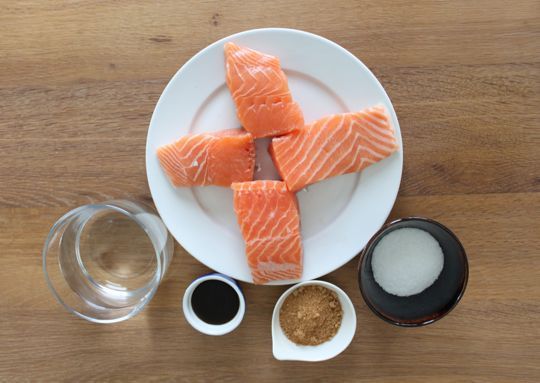
1 pound wild salmon, skin on, 1 to 2 inches thick (450 g/2.5cm to 5cm)
1 quart cool water (950 ml)
1/4 cup kosher salt (75 g)
1/4 cup brown sugar (75 g)
1/4 cup coconut aminos (optional, for flavor only) (60 ml)
Equipment:
A large handful of wood chips. Alder, apple, cherry, oak or maple work fine. Don’t use mesquite, the flavor will overpower the salmon.
Wok with a lid
Aluminum foil
Cooling rack (to dry fish)
Round cake rack that fits inside of the wok
Instructions:
Cut salmon fillet into four even pieces. The salmon will cook best if each piece is generally the same thickness all over. In a large bowl combine salt, sugar and coconut aminos with 1 quart of cool water and stir until the sugar and salt are dissolved. Add the fish to the bowl and brine for 8 to 12 hours.
Take your fish out of the brine and pat it dry.
Put the fillets on a cooling rack set over a baking sheet, skin side down. This step is important to dry out the surface of the salmon before smoking. There are two ways of doing this. One, place the fish in a cool room under a ceiling fan or near a regular fan for 2 to 4 hours. Or, put the rack of fish uncovered in the refrigerator for 8 to 12 hours.
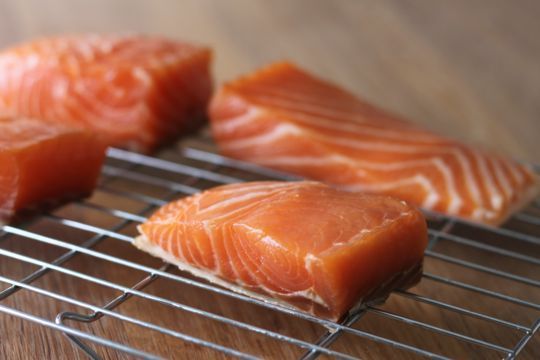
After the fish has completed the drying process, then make your smoker:
Line a wok with two big pieces of foil that hang over the edges by 4 to 6 inches (10 cm to 15 cm).
Add a thin layer of woods chips. Set a small round cake rack over the chips.
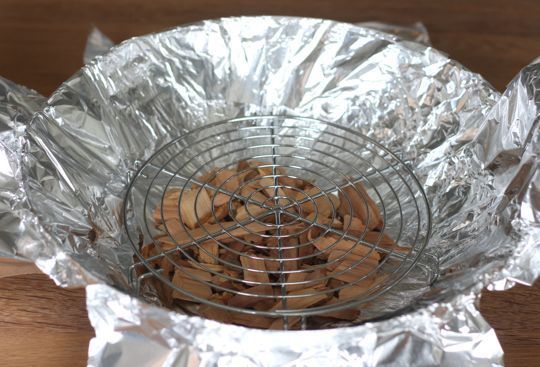
Place the salmon on the rack, skin side down.
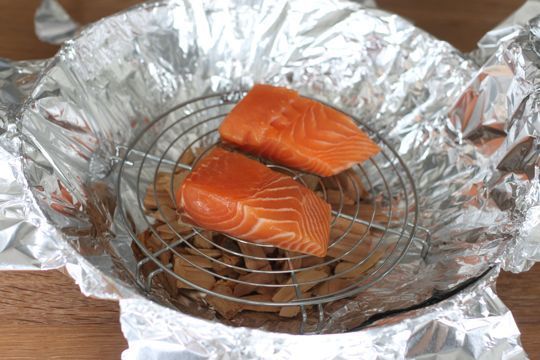
Bring the sides of the foil up over the salmon, pinching the ends closed to form a tent in which the smoke can circulate around the salmon. The tighter the foil is sealed, the less likely that smoke will escape out into your kitchen.
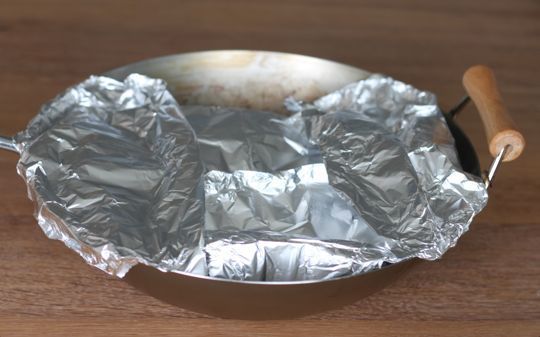
Put the lid of the wok on tightly.
It’s a good idea to smoke one fillet alone first, to get a sense of what your ideal smoking time is both for the flavor of fish and the doneness. After you experiment with the first fillet, you can then smoke the remaining three fillets at the same time. As a guideline, use these smoking times and heat levels for salmon with a robust smoky flavor that is cooked all the way through. 1-inch thick fillet: Turn the heat on the gas stove to medium-high for 4 minutes, then down to medium for 12 minutes. 2-inch thick fillet: Turn the heat on a gas stove to medium-high for 4 minutes, then medium for 20 minutes.
Cooking Tips:
You can peak inside to check on the progress, even break off a piece of salmon to try, and then re-seal the foil and keep smoking if it’s not done.
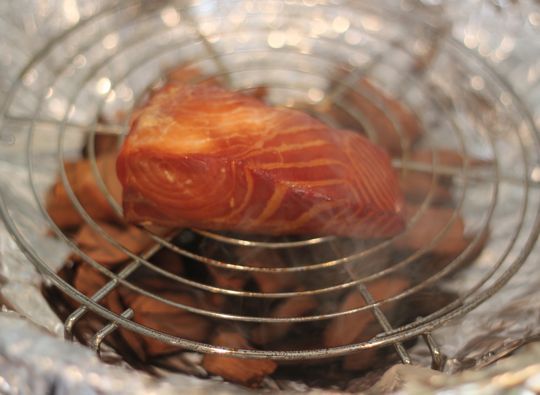
If the flavor of your first fillet turns out too smoky for your taste, then keep the fillets in the wok for a shorter amount of time and finish cooking the salmon in a 200 ºF/93 ºC oven.
Hot smoked salmon is fully cooked. Although regular hot smoked salmon (smoked in a real smoker) keeps longer, when using this specific method to smoke salmon, it’s best to eat it within a few days.
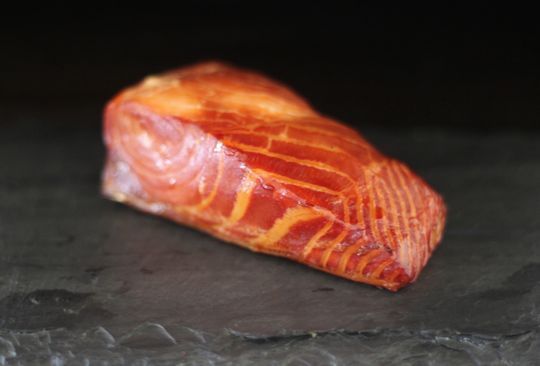
Not Sure What to Eat? Get the Primal Blueprint Meal Plan for Shopping Lists and Recipes Delivered Directly to Your Inbox Each Week




May 16, 2014
Complete Turnaround After Only Two Months
It’s Friday, everyone! And that means another Primal Blueprint Real Life Story from a Mark’s Daily Apple reader. If you have your own success story and would like to share it with me and the Mark’s Daily Apple community please contact me here. I’ll continue to publish these each Friday as long as they keep coming in. Thank you for reading!
 After just two months it may be a little soon to be sending you one of these, but I just had to share.
After just two months it may be a little soon to be sending you one of these, but I just had to share.
I am a 30 year old police officer in FL. Ever since middle school I have been the fat kid. No matter how hard I tried the conventional way, I could not lose any weight and just kept getting heavier. Even the police academy only helped a little and as soon as it was over, the weight started piling back on (long hours of sitting and fast food). While I knew that I was overweight, I still didn’t worry too much about it because I was always the healthy one in my family. My immediate family is plagued with diabetes, thyroid issues, chronic asthma and allergies, rheumatoid arthritis, obesity, IBS… like I said, I was the healthy one.
My department gives us a pretty comprehensive wellness exam every year (blood work, ultrasound of major arteries and organs, stress test, fitness test, etc.). They didn’t have to tell me that I was fat, but last year my blood work really bothered me. My triglycerides were 252 and my HbA1c was 6.0% putting me at an increased risk for diabetes. That one really hit me hard given that I have a grandfather, father, and brother all with diabetes. So I decide to “make a change,” by doing all the crap that didn’t work before… just more of it. I ran more, and lifted more, and ate as much “healthy whole grains” as I could. By the end of January this year (2014) I was at the heaviest I have been in my entire life; 278 lbs.

My daughter’s 2nd birthday, 2/8/2014.
Around the beginning of February, a friend gave me a workout routine that he used to get ready for SWAT tryouts. It included low-level cardio staying within your target heart range, 3 days of weightlifting and 1 day of sprinting per week. Kind of sounds familiar, right? One line in the routine said something about sprinting being unmatched in terms of weight loss and muscle growth. That piqued my interest because I have always enjoyed sprinting and despised distance running, so I started doing some online research. A quick search brought up an article on some obscure website called Mark’s Daily Apple. I didn’t really care what some random guy had to say about sprinting so I skipped that link until I had read all of the more “official” looking ones. Looking back, I should have gone to MDA first and saved myself a lot of time.
While going through your articles on sprinting, I came across another article that changed my whole outlook on life; The Definitive Guide to Insulin. Given my family history and rising HbA1c this one caught my attention. I read that article while at work on February 13th, 2014 and immediately gave up grains cold turkey. I have never looked back. I then bought your book and have become a faithful follower of MDA.
I still have quite a way to go in my journey to true health but here is what two months of The Primal Blueprint has done for me. I have lost 36 pounds. My body composition has change dramatically. I am wearing clothes that I wore when I was still 20 pounds lighter than I am now. I am happier than I have been in a long time and not as cranky as I was before. I have so much more energy; I’m not tired and dragging all the time.

My brother’s wedding, 3/31/14. I’m far right. Others from left to right are my dad (type 1 diabetes), brother (rheumatoid arthritis), and brother (type 1 diabetes).
Like I said, I still have a ways to go to get to my ideal body composition, but the reason I am going ahead and writing to you is because I just went for this year’s wellness exam. After another 9 months of adding to the problem and then only two months of living Primal, the results were incredible. My triglycerides went from 252 to 165 (I know still high but a big step in the right direction). My HbA1c went from 6.0 (I’m sure it was even higher by the time I started) to a normal level of 5.4. NO LONGER AT RISK FOR DIABETES!!! My body fat percentage went from over 30% down to 20%. The fat is disappearing from my fatty liver, and my stress test numbers improved greatly over last year.
I started this experiment on myself because I wanted to be around a long time with my little girl. Not only that, but I wanted to actually be able to play with her and enjoy our time instead of being groggy and cranky. I have since become a strong advocate of the Primal Blueprint and of your site. My partner at work is now doing it with me and I have been preaching it to others too. Now that I have myself on the right track, my next goal is for my family. After reading another book on the effects of modern wheat, I think grains are a huge part of my family’s medical issues. I think I am driving them crazy with MDA links, but now that they are seeing results in me, I think some of them might be coming around.
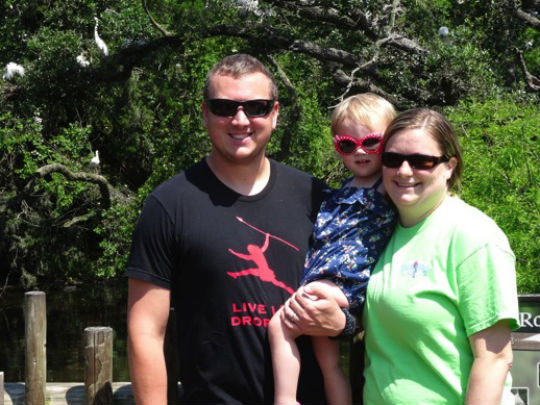
St. Augustine Alligator Farm, 4/23/14.
Thank you, Mark, for fighting against conventional wisdom and sharing your own experiences with the world. I know I would not have been where I am now (and looking forward to tomorrow) without MDA and I’m sure that I’m not the only one.
Robert
Get the 7-Day Course on the Primal Blueprint Fundamentals for Lifelong Health Delivered to Your Inbox for FREE




May 15, 2014
Improve Your Workouts with This One Simple Trick
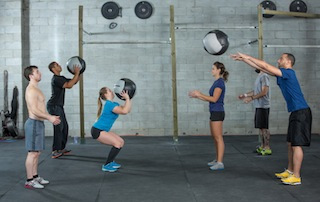 Every once in a while I run across a study that makes me laugh even as it makes me think. Such was one in a gaming journal (admittedly unfamiliar territory to me). The study assessed the comparative impact of varying degrees of “human-like, software-generated” workout partners (e.g. “a nearly-human-like, humanoid partner (NHP), a hardly human-like, software-generated partner (HHP),” against one another and a no partner control as well as a genuine hominid presented virtually. The concept made me chuckle as I pictured the potential animation, but the results gave me something to consider. Subjects’ motivation was higher and generally the same in any of the partnered conditions, no matter how “hardly human-like” the partner. Other factors like perceived exertion, enjoyment or self-efficacy were also relatively constant among the partnered scenarios. The only significant difference measured was persistence, where the virtual hominid took top honors. (Grok would be proud – or just wholly befuddled.) The conclusion, as drolly described in the title of the study, was “Cyber buddy is better than no buddy.”
Every once in a while I run across a study that makes me laugh even as it makes me think. Such was one in a gaming journal (admittedly unfamiliar territory to me). The study assessed the comparative impact of varying degrees of “human-like, software-generated” workout partners (e.g. “a nearly-human-like, humanoid partner (NHP), a hardly human-like, software-generated partner (HHP),” against one another and a no partner control as well as a genuine hominid presented virtually. The concept made me chuckle as I pictured the potential animation, but the results gave me something to consider. Subjects’ motivation was higher and generally the same in any of the partnered conditions, no matter how “hardly human-like” the partner. Other factors like perceived exertion, enjoyment or self-efficacy were also relatively constant among the partnered scenarios. The only significant difference measured was persistence, where the virtual hominid took top honors. (Grok would be proud – or just wholly befuddled.) The conclusion, as drolly described in the title of the study, was “Cyber buddy is better than no buddy.”
The study got me thinking about the advantage of social support and group exercise. As I mentioned in yesterday’s post, working out with other people can offer a unique and heightened euphoria that goes beyond physical activity itself. Beyond the obvious Primal associations, our group fitness endeavors offer us a better endorphin release, resulting in greater pain thresholds and even an oxytocin kickback for bonding with said co-participants. What’s not to love?
While the body of research directly comparing solitary exercise with group workouts isn’t as expansive as it might be, other studies have likewise supported the benefits of “social” fitness in one context or another while simultaneously highlighting the complexity of the social “experience” in exercise. One study, for example, showed that group exercise participants experienced greater calmness than those who exercised alone (with self-reports prior to exercising controlling for initial emotional state). However, the group exercise subjects reported being more tired after exercise, which researchers speculate may come from the “increased competition or workload” in a social workout situation.
In another study, subjects reported lower perceived exertion when exercising in the presence of another person than when exercising alone. In a second experiment, participants who exercised next to someone who gave nonverbal cues suggesting the workout was easy reported less exertion. Cues suggesting the workout was more intensive didn’t appear to have a significant impact on subjects’ sense of their own effort. While no physiological differences were observed, the study experiments do underscore the psychological influences the social factor can have.
On that subject, it appears we don’t need a ton of individual verbal encouragement but may be better motivated by the desire to keep up with a more skilled partner - particularly a more skilled partner we believe is on our team. Subjects dramatically increased their exertion (by 90%!) when told a partner in another lab visible on video (actually just a looped recording) had biked longer than they had. Likewise, when one group of subjects was told the person in the video was on their team competing against others, they again boosted their performance. At first, the increase was modest, but over time (as subjects apparently felt more invested in the contrived team relationship), their exertion rose to 160% greater than a simple partnered group and 200% greater than the solo exercisers.
Finally, it appears that even the gender of a simple observer placed in laboratory conditions can impact perceived exertion. In one of those “duh” findings, males reported a significantly lower perceived exertion when a female observer was present and a higher perceived exertion when the male observer was present. Both measures were compared to a no-observer control. When we up the ante and look at actual enjoyment, the picture gets a little fuzzy. In one study, both men and women enjoyed exercise less when an “attractive” female (no, the researchers didn’t do the same experiment with an attractive male – I’m just the messenger) was working out next to them than they did working out alone.
Gender and attraction aside, the social exercise advantage as a whole could be seen as either a subset of social support – or perhaps an extension of it. Countless studies have demonstrated the value of supportive relationships in exercise adherence, but the “support” can vary substantially. Consider the supportive spouse who covers extra home duties while you fit in your daily training or the people who comment on your FB gym “check-ins” or a close friend telling you she’s inspired by and proud of your fitness commitment. How about the colleagues at work who you see at the office gym during your lunch hour workouts – the ones who always say hi and offer encouraging words. You bond a bit over the common dedication but don’t really exercise together. Then there are the people who you consider “your people” at the gym. Maybe you lift together or do a class or running club together. Maybe they’re a weekly walking partner or group. You’re all in the same boat (or maybe even officially a team) working your way toward whatever goal – whether it be weight loss or competition level performance. How would you assess the role or influence of these different supports in your fitness life?
Increasingly, there’s an interest in capitalizing on the influence of others. One app company is even marketing the concept of a “fitness tribe,” in which two or more people buddy up (on the app or in the real world) to share their health commitments and the daily actions that get them there. The concept is certainly a practical one, and I happen to believe that there’s something to virtual community when it can supplement our physical social networks and when it allows us to connect with those who share specific interests (e.g. Primal living). While a virtual “tribe” may not offer all the advantages of an in-person experience, the company’s research suggests those who “team up” with others benefit from making their endeavor “social” instead of “solo” by the regular encouragement in their virtual fitness circle and by its frequent extension to real life contact with workout dates and fitness event participation. Many MDA folks have been connecting in these ways for years, and I hear regularly from readers who have gone from signing up for the newsletter to attending PrimalCon and organizing Primal Meetups in their localities for everything from workouts and potlucks. I think this extension into the real physical realm can be key for many people. All this talk of virtual and networked support aside, there’s something to the concrete presence of another person there on the track, gym floor or hiking trail. We’re wired to respond to the physical nuances of another person’s presence even though we respond to virtual (or even computer-generated) versions of social workouts. If nothing else, I always suggest not settling for something lesser when the something better is wholly available. Sometimes the questions is simply, “Why compromise?”
All this raises the question of gradation. What social fitness experiences are the best in terms of psychological support or motivational influence? It’s something that we probably have to ascertain individually, but some experts suggest the more the group has in common in terms of values (Primal, anyone?) and the more substantial their individual investments, the more supportive and beneficial the group environment. In other words, going once to a drop-in fitness class isn’t the same as working out regularly with the same group of people in a team or club setting.
Finally, there’s the question of whether working out in a group is really worth it for those who genuinely prefer the solo time. For many people, their fitness hours are also their only (or at least most valuable) solitary hours. Some of us crave the solitude. Working out offers us needed time to be alone with our thoughts or without any stimulation, save the input of our muscles and our favorite playlists or park setting. To those who would argue that social fitness is an exercise in frustration more than anything else, I’d say there are countless ways to fill the social well. Social or solo, your body will thank you for it.
Thanks for reading, everyone. What’s your exercise preference? Do you experience an added benefit of working out with others? Offer your feedback, and have a good end to the week!
Join Mark Sisson and Friends at the Mohonk Mountain House this June 5-8! Get Your Tickets for PrimalCon New York Today and Finally Meet Your Tribe!




May 14, 2014
How to Get High on Life: 10 Natural Ways to Feel on Top of the World
 Many of society’s favorite psychoactive compounds, both legal and illegal, work by hijacking our own neurotransmitters and brain receptor sites. In other words, they aren’t creating something out of nothing nor are they necessarily imposing an alien influence. They only work because our brains are set up to get high and feel pleasure.
Many of society’s favorite psychoactive compounds, both legal and illegal, work by hijacking our own neurotransmitters and brain receptor sites. In other words, they aren’t creating something out of nothing nor are they necessarily imposing an alien influence. They only work because our brains are set up to get high and feel pleasure.
Why does pleasure exist? Pleasure is the carrot dangled by the body to get us to do the things we need to survive and prosper. It helps us reach important survival goals. But we’re not ascetics. Experiencing and appreciating pleasure as its own entity is necessary for true happiness and life contentment. Our genes expect us to feel good, not just do the tasks that feeling good compels us to complete.
So today I’m going to tell you how to get high and hit these pleasure centers, Primal style. If that sounds like it involves a shaman, some cactus cuttings, and monotonous chanting over a fire, I don’t blame you. That’s absolutely one way to get high and it’s probably similar to how Grok did it, but this isn’t an ayahuasca recipe post, a review of peyote churches, or a guide to “Choosing the Right Fat-Busting Entheogen For Your Body Type.” This is a post discussing the ways our bodies can naturally achieve mind-blowing, consciousness-expanding levels of elation and euphoria.
Exercise
It’s popularly known as the runner’s high, but you don’t have to run to feel high from exercise. The best known, mother of all natural highs can have you skimming the clouds. Its soaring yet soothing effects are some of the reasons I stuck with endurance training for so long despite the other negative effects it was having. The latest research indicates that the high is probably mediated by two endogenous chemicals: beta-endorphin, an endogenous opioid involved in pain reduction and relaxation; and anandamide, an endocannabinoid responsible for pain reduction and euphoria.
The exercise high probably influenced human evolution, helping promote the highly active lifestyle necessary to dominate the environment. When the going got tough (like when a saber tooth tiger was right on their heels or when they were chasing down dinner), euphoria and pain reduction would have been invaluable.
Studies indicate that it takes about an hour of endurance training for beta-endorphins to release, whereas short-term anaerobic training produces significant levels of the opioid (the more intense the better). In another study, an acute bout of Olympic weightlifting caused elevations in beta-endorphin. This was low-volume resistance training, no more than ten or fifteen seconds of actual honest work, but the intensity was high enough to provoke the exercise high. Overall, it’s high intensity anaerobic work that produces the biggest endorphin rush. As for the endocannabinoids, intensity is key there, too.
Group Workouts
Just as exercise itself can spur a euphoric state, exercising with others may offer a different and arguably better high. One study found that rowers’ pain thresholds were greater after training as a team than after working out alone. Since pain sensitivity is a marker of endorphin release, the group workouts produced more of a high. In another study, players engaged in a high-pressure soccer shootout enjoyed bursts of oxytocin, the “love hormone,” after celebrating. Not only that, but the oxytocin surges were contagious across teammates, bringing them closer to each other and strengthening bonds.
The more our ancestors enjoyed working together, the better their chances of surviving. This may be why CrossFit is so popular, and it’s one more reason to take up Ultimate Frisbee (my personal favorite of course), join that basketball league, or convince a buddy to do some sprint competitions. Check back tomorrow for more on group workouts.
Extreme Sports
Whether it’s bungee jumping, mountain climbing, snowboarding, cliff diving, sky diving, or base jumping, some of us flock to extreme sports like moths to the flame. The appeal is obvious (even if you don’t personally subscribe to it): extreme sports place the body into remarkably stressful situations. It’s physical exercise, yes, but it’s also mental exercise. When you’re leaping from a cliff or plane, your lizard brain thinks you very well may die. The result is a rush of powerful hormones, including adrenaline, dopamine, and beta-endorphins (which correlate closely with reports of euphoria). Your heart works harder and faster, sending more blood, more quickly to the muscles as well as the brain. Your senses are heightened. Time slows down. Moments linger longer than ever before. It’s all a stop-gap mechanism to help you survive the situation.
Even if you’re not a mindfulness practitioner, extreme sports will force you to savor the moment. Dangerous situations – perceived or real – tend to have that effect. There’s the afterglow, too. After the hormonal explosion has abated and you’re back on solid ground, you’ll feel calm and accomplished and carefree. Stress melts and stays away, because what can compare with flinging oneself off a mountain into open air?
You hear talk of “adrenaline junkies,” as if snowboarders and base jumpers and free climbers are little more than healthy meth addicts – and I think that’s the wrong way to describe what we’re doing out there. What we’re drawn to is the intense, hyper-real focus and awareness that our body produces as a response to the incredible insanity of the situation. It’s not about the risk itself as much as a testing of skill against the very immediate, potent backdrop of survival.
You’re somehow never as in touch with life as you are when you’re walking the edge of it. Was that a Bon Jovi lyric? It should have been.
Spicy Food
Think of the spiciest food you ever ate. I’m not talking Tapatio, Tabasco, or Cholula here. I mean the kind of hot that makes you anxious and queasy and regretful.
The kind of spicy that would make a WAPFer chug the nearest glass of ultra-pasteurized A1 beta-casein skim milk to quell the burn. Maybe it was a lamb curry or a Jamaican jerk sauce. Maybe you got caught up in a chile-eating contest in Tijuana. Whatever it was, you never forget what it felt like or how much you wanted to take a fire hose to your insides. And I bet you felt something else when you ate it, not just the heat on your tongue. Didn’t you?
Although the more sensitive among us might have simply been scarred for life by the heat, others who have ventured deep into that hot terrain tell tales of a much mellower after effect, a uniquely pleasurable calm. Chili heads, as they’re known, are experts in this spice-induced serenity. They’ve grown to love the heat from start to finish.
There’s no strong, incontrovertible evidence that eating hot food has psychoactive effects in humans, though some animal evidence suggests that capsaicin (the main spicy component in peppers) can release beta-endorphins and adrenaline. It also has analgesic properties which may be mediated by activation of the central opioid system. Still, there’s usually a physiological justification for odd human behavior. If people are happily eating food that literally burns their mouths and insides, there’s a good chance there’s something in it for them. I suspect that the pain gives way to pleasure, and that cool pool of biochemical pleasure afterward is indeed the result of endorphin release. After the pain/danger has dissipated, an intense calm pervades.
I’m a believer. One morning in Thailand, I met a young backpacker staying at the same place we were. I was in the common area looking for coffee. He was dumping a sack of red powder into a small glass of water. He mixed it together and tossed it back, making a face reminiscent of a teen trying cheap gin for the first time. Turns out he was taking shots of powdered Thai chiles. Said it was better than coffee and offered me a shot. I accepted, of course. It was about two teaspoons of powdered chile (about as hot as cayenne; not to be confused with chili powder) in a couple ounces of water. I took it, shot it, and probably made the same face he did, but it woke me up. It may have been placebo (though I wasn’t expecting much), but I swear I felt buzzed, really calm yet energized for an hour or two after. I’m a longtime fan of spicy food and can take it pretty hot, so your mileage may vary. Exercise caution.
Love
Falling in love is the ultimate high in most people’s book. You’re at times an utter (albeit blissful) fool who’s checked half his/her brain at the door or the pinnacle of confidence and contentment skimming along life, undeterred by any burden or barrier.
And damn, does it feel good. A review of studies demonstrates that no less than twelve different brain regions are activated by the cascade of chemicals like dopamine, adrenaline, vasopression, serotonin, and oxytocin when we fall in love. Endorphins and PEA (the chocolate/love drug) also play a big role in the neurochemistry of love. As a result, we feel happy and dopey. Confused and excited. Anxious and confident. We’re a mess, basically, a hastily thrown together assortment of neurochemicals all vying for agency. But you can’t wipe that grin off your face when you’re in the thick of it, can you?
What if you’re already settled down with someone? What if that heady blast of new love has long since passed?
Value your relationship. Nurture it, feed it. Spoil your partner, act like it is the early days. Experience them in the fullest possible way. Recall those initial romantic days and do it over again. Relish good memories. Make new ones. In a couple words: be present.
Nature
Most of us are so divorced from our ancestral home – the natural outdoor environment – that leaving the city and going where the cell towers don’t reach feels like entering an altered state of consciousness. Probably because our consciousness has changed. I know when I’m out there, whether it’s at a secluded beach, deep in the redwoods, or alone on a snowy mountaintop, I feel different. I notice new things. My brain works better. I’m high by virtue of eliminating the extraneous sensory clutter of the city.
Sex
Having sex releases a torrent of endogenous drugs, hormones and neurotransmitters so expansive that Hunter S. Thompson and William Burroughs would raise an eyebrow. During arousal, your body secretes the powerful stimulants adrenaline and noradrenaline. Your heart is racing, your blood pressure rises, all in the service of delivering extra blood to various important body parts. Upon climax, your bloodstream is treated to an intoxicating cocktail of prolactin, oxytocin (a.k.a. cuddle time), phenethylamine (levels of this love and chocolate chemical peak at orgasm), and dopamine (care of primal reward system for all around opiate-induced bliss). During male ejaculation, the (male’s) brain apparently lights up like a heroin user’s right after shooting up, indicating a major role for opioids. Neuroimaging studies on women during orgasm also reveal significant activation of the brain’s pleasure centers.
One more thing: everyone focuses on the orgasm, but don’t forget to savor the journey. Take your time with the foreplay and the actual act of sex. You’ll arrive eventually, no need to rush it.
Music
We’ve all heard – or performed – music that has left us with goose bumps and chills. We’re utterly struck by it, held by it, entranced and touched in such a deep way that we feel moved physically and spiritually. I always think of a concert Carrie and I took in some years ago – a choral performance that ended with a piece so piercing and transcendent that it took my breath away. The hairs on my neck and arms stood up and I was swept up in some collective out of body experience. To this day, listening to the piece catapults me back in time and I feel it in my gut.
Science has confirmed the existence of the euphoric music-induced “chills.” Researchers asked participants to choose music that gave them the “chills” each time they heard or played it. Then they allowed subjects to listen to the music while they monitored their brain activity with PET imaging. (In other parts of the experiment, they listened to other peoples’ musical selections or general noise.) Each participant’s chosen music, the researchers found, exclusively produced activity in brain areas associated with “euphoria-inducing stimuli, such as food, sex, and drugs of abuse.”
The researchers suggest that as humans evolved they developed the ability to experience euphoria from more abstract activities like music. Although unnecessary for hard scrabble survival, music likely contributed to social bonding and the cohesion of human communities, which in turn aided survival. Music is also a way to tap into the rhythm underlying life itself. You won’t find any clinical trials, but there’s real music happening right under our noses every single day. Musicians just reveal it.
Dream
Remember how you’d hang out at night with your friends, looking up at the stars, just thinking and talking about how immense and crazy and impossible and possible everything is? Remember when you were filled with wonder? Dreaming is one thing that still gets to me and makes me feel like a kid again. Best of all, we have direct access to it. It’s the great mystery that we get to explore every single night of our lives.
Every night, we enter a fantastical world of our own creation. In this world, time is relative; we can live out entire lifetimes in the span of a single sleep cycle. We become artists, novelists, world-builders and storytellers that put Tolkien, Spielberg, George RR Martin, and Salvador Dali to shame. And we get to live and breathe and act in those worlds as if they were real. It’s amazing.
What’s going on here, chemically? Some researchers think that our brains release very small amounts of dimethyltryptamine (DMT), a powerful psychedelic compound, during sleep. That certainly seems plausible.
Humor
Laughter’s a funny thing. It’s contagious. The very act of producing the muscular contractions responsible for laughter release beta-endorphins. And there’s nothing like a belly laugh. The weirdest part of all is that it has a mind of its own and cannot be tamed. If something is really, truly funny, you’re going to laugh and there’s not a thing you can do about it. You know how it is – we all have that memory that makes us laugh just thinking of it. Or that friend in class who could get you to laugh just by glancing at you? Or how about the uncontrollable ten minute laughing fit that turns into an ab workout and feels like you’re possessed by a surprisingly lighthearted demon? It’s insane, in a good way.
Laughter yoga shows that laughter can be consciously performed without anything funny happening and it will still have a positive impact. You can in effect fake it till you make it. But that’s not very funny and I’d suggest going for the real deal. Head out on the town with your funniest friend or kick back with the movie or TV show that makes you laugh until your face hurts.
Thanks for reading today, everybody. I’d love to hear your thoughts. Additions, thoughts, amusing anecdotes? What are your favorite Primal highs?
Join Mark Sisson and Friends at the Mohonk Mountain House this June 5-8! Get Your Tickets for PrimalCon New York Today and Finally Meet Your Tribe!




May 13, 2014
Does Skinny Equal Healthy?
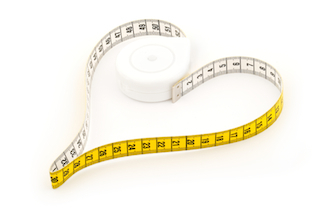 Everyone has that friend with an interdimensional portal for a stomach. They eat whatever they want in massive quantities and never seem to gain a pound. They’re skinny, despite their best efforts to the contrary and our barely concealed envy. And everyone assumes that they’re healthy because they’re skinny.
Everyone has that friend with an interdimensional portal for a stomach. They eat whatever they want in massive quantities and never seem to gain a pound. They’re skinny, despite their best efforts to the contrary and our barely concealed envy. And everyone assumes that they’re healthy because they’re skinny.
But are they? Is skinny all it’s cracked up to be? Does it always equal healthy? Are these effortlessly skinny people more likely to be healthy than the person who struggles with their weight and has to watch what they eat?
There’s no easy answer, of course. This is the human body we’re talking about – that repository of confounding variables, shifting contexts, and paradoxical effects. Declarative, absolutist statements about it are almost guaranteed to be proven wrong. And this time is no different.
It turns out that while it’s generally healthier to be slimmer than fatter, skinniness doesn’t guarantee health. There are caveats (tons) and exceptions to the rule (that isn’t really even a rule).
As my first example, I submit the skinny-fat young-ish cool dad.
They look slim and lean in clothes and definitely sport a normal BMI, but underneath they’re doughy. I see it a lot in new, 30-ish dads. Guys with slim cut jeans, a band t-shirt or flannel depending on the weather, interesting facial hair, and a protruding gut. Fifteen years ago, they’d probably have a chain wallet. They’re not particularly active (since little Bronx was born, you can count on a Simpsons character’s hand the number of times they’ve taken the restored Bianchi out for a ride), can maybe bust out one or two pullups (or two or three chinups), and look healthy and fit enough in clothing. Lack of sleep paired with too many IPAs and too little time to cook proper food or exercise are to blame.
A controversial term, skinny-fat. But here’s what I mean by it: normal or underweight BMI coupled with high body fat. It exists. Just like a common (and valid) complaint is that BMI overestimates the unhealthy overweight population by failing to account for people with a high lean body mass, BMI also overlooks the people with low body mass but high fat mass.
A sciencey way to describe this phenomenon is the metabolically unhealthy non-obese (MUHNO). They’re also known as metabolically obese normal weight (MONW). A MUHNO has at least two of the following metabolic characteristics while retaining a normal weight BMI: triglycerides over 150 mg/dl, fasting glucose over 100 mg/dl (or diabetes), elevated C-reactive protein (marker of inflammation), elevated HOMA-IR (marker of insulin resistance), HDL under 40 mg/dl, systolic blood pressure over 130 and/or diastolic blood pressure over 85. MUHNOs may look healthy and skinny and “normal,” but their metabolic health puts them at a greater risk for several conditions:
MUHNOs have an elevated risk of early atherosclerosis.
They’re more likely to develop diabetes and cardiovascular disease.
They have poorer glucose tolerance and secrete more insulin in response to food.
Their LDL particles are smaller and more easily oxidized.
MUHNOs tend to have more unhealthy visceral fat around the organs than metabolically-healthy normal weight people, which probably explains the differences in cardiovascular risks between the two groups. And this abdominal obesity is associated with a mortality risk from heart disease even higher than other groups with different body fat patterns.
Next, take the hardcore methionine-counting CRONer, consistently restricting calories and key amino acids for a chance at eternal life.
He’s hunched over a keyboard, discussing supplement stacks, sipping Soylent, counting down the days until the Singularity hits and he’s free from the abomination that is the human body. He may very well live a long time – calorie restriction does show some promise – and he’s very thin, but is he healthy?
If he’s bone-thin and so frail he regularly loses fights with gentle breezes, no. If his idea of lean mass is sinew and ropy tendon, he’s in trouble. Skinny isn’t just skinny. It’s also scrawny. It describes a lack of fat and muscle. It means underweight. A skinny person offers a live lesson in skeletal anatomy without all that lean mass obscuring the view. Lean mass – solid muscle, strong dense bones – is important for health, as we know by now.
Lean mass doesn’t save you from everything, though. Consider the contest-ready bodybuilder.
Though he has more muscle mass than he knows what to do with, the contest-ready bodybuilder is in full metabolic shutdown. His heart rate has slowed to 27 beats a minute. His strength has diminished and never quite recovers, not even after 6 months. Testosterone has plummeted. His total mood disturbance (a marker of mood; higher is worse) has increased from 6 to 43. Going from 14.8% BF to 4.8% BF for the contest and back to 14.6% during recovery takes a toll. 4.8% BF simply isn’t sustainable or healthy.
Are you skinny? It doesn’t mean you’re healthy… http://ctt.ec/pfez5+

The pros know this to be true. They understand that walking around at competition levels of leanness is foolhardy, that competition leanness needs to be cyclical, not constant. But a lot of regular fitness enthusiasts working out and dieting down have the idea that 4-5% body fat is not just desirable, but healthy and optimal for everyday life. It’s not. It’s terribly unhealthy, as the case study linked to above shows.
In the elderly, skinniness can mean poor health.
Is skinniness indicating or causing illness in the elderly? Or both? It’s a tough relationship to parse, but it’s definitely a relationship:
Underweight (and obese) elderly men have reduced respiratory function, though increased lean mass can attenuate the relationship. Respiratory disease is a major killer among the elderly.
Following critical care, the underweight elderly are more likely to die and, if they survive, display impaired functionality. Other studies confirm.
Both elderly men and women who are underweight have lower bone mineral density, albeit for different reasons. Low body weight is bad for men because it often means low lean mass. Low body weight is bad for women because it indicates less overall fat mass, and fat seems to help elderly women maintain bone density. Either way, being too skinny is bad for their health and can lead to falls and bone breaks.
For elderly people, becoming skinny may be bad and likely indicates worsening health or the development of an illness. Weight stable skinniness is probably better.
Finally, consider the female. Since I already wrote an entire post about the importance of body fat in women, I won’t get too deep. To a woman, extreme skinniness may be especially unhealthy. Women actually need more body fat than men to be healthy, and it goes in different places (butt, thigh, hips) that serve as storage facilities for baby brain construction material. You may not want to have a baby, but the ability to do so is a strong indicator of good health. There’s even something specific to women called the female athlete triad. Characterized by extremely low body fat and extreme energy deficits, the triad can result in amenorrhoea, osteoporosis, and infertility.
Can we make any blanket statements at all?
The right amount of leanness is healthy. Of course, the “right amount” depends on many variables, like sex, age, baseline health, as well as interpersonal variation. One person may be perfectly healthy at 8% body fat, while another might need 15% to be healthy. One woman may lose her period and develop osteoporosis at 14% body fat, while that same body fat percentage could be perfectly adequate for the next woman.
For all the statistics and correlations I’ve referenced in today’s post, they don’t represent the outliers in every group. If they don’t apply to you, they don’t apply to you. Don’t take offense and seek redress. Take pride in your individuality. Skinny old granny with a strong grip and stronger bones? Keep doing what you’re doing.
All else being equal and eliminating any underlying health issues unrelated to body weight, a slim person is probably healthier than an overweight or obese person, yeah. But nothing is really equal, is it? Life doesn’t work that way. It’s not neat and tidy.
If you take anything away today, I hope it’s the knowledge that skinny does not necessarily equal healthy. There is such a thing as “too skinny” – for everyone.
Join Mark Sisson and Friends at the Mohonk Mountain House this June 5-8! Get Your Tickets for PrimalCon New York Today and Finally Meet Your Tribe!




May 12, 2014
Dear Mark: Tweaking Sprints for a Stressful Life; Carrie’s Primal Transition
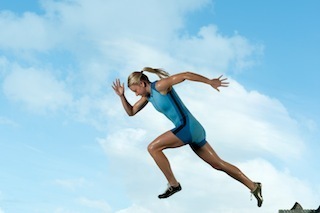 For today’s edition of Dear Mark, I answer one question and Carrie answers another. First up is one from Diane, a (full-time) working mother who’s noticed something interesting about her variable response to sprinting: when she’s relaxed and low-stress or on vacation, sprints lean her out; when she’s working and inundated with stress and responsibilities and concerns, sprints make her retain or even gain body fat. Since she realizes the power of sprinting and doesn’t want to give it up completely, Diane wants a few tips for hacking sprints on a high-stress lifestyle. Next, Carrie gives a quick overview of her transition into the Primal lifestyle and breaks down what Primal living looks like for her these days.
For today’s edition of Dear Mark, I answer one question and Carrie answers another. First up is one from Diane, a (full-time) working mother who’s noticed something interesting about her variable response to sprinting: when she’s relaxed and low-stress or on vacation, sprints lean her out; when she’s working and inundated with stress and responsibilities and concerns, sprints make her retain or even gain body fat. Since she realizes the power of sprinting and doesn’t want to give it up completely, Diane wants a few tips for hacking sprints on a high-stress lifestyle. Next, Carrie gives a quick overview of her transition into the Primal lifestyle and breaks down what Primal living looks like for her these days.
Let’s get into it:
Hi Mark,
I have a question about sprinting. I have been living the primal lifestyle for over 3 years now, have the food and exercise dialed, however encounter daily stresses of raising young children and full time corporate work. I incorporate sprinting once a week, however seem to retain or GAIN fat on my stomach after sprinting. When I am on vacation and relaxed, the sprints work like they are meant to and shed fat. Should I not be sprinting while leading a stressful life, as I appear to be adding cortisol to more cortisol which is leading to belly fat? I would hate to give up my sprinting as I love the other benefits they bring such as increased power and ability to chase after my children. I currently run 8 x 30 second sprints with 90 seconds recovery in between, on a track or up a hill. Is there a way to tweak my sprints so that they are not so stressful to my body.
Thanks so much,
Diane
Okay, first off: great job being cognizant of how sprints affect your body differently depending on the baseline level of stress in your life. That’s huge.
It can be disconcerting to see weight come on or stay put despite best efforts. It’s not fun to be “sensitive” to stress-related weight gain. But I actually think it’s a blessing in disguise.
Most people drift through life gaining weight here, losing weight there, eating this, exercising that way without ever putting two and two together. They’re rarely ever able to optimize their eating, exercising, and other lifestyle factors based on any real world, personable evidence. They do what someone else says – maybe me, maybe some other “expert” – and hope for the best.
Your sensitivity and your intuition allow you to spot incongruities and intolerances. You have the ability to tailor your lifestyle to your body and its requirements. You know what works for you and what doesn’t work because you notice what happens when you change a routine.
That’s rare and it’s awesome. Cherish it. Use it.
Now, some thoughts on sprinting and a stressful life.
Eight 30-second sprints with just 90 seconds of rest in between are kind of a heavy load for anyone, let alone a heavily-stressed working mother. Many of the most effective sprinting studies employ four – not eight – 30-second sprints with three to four minutes – not 90 seconds – of rest in between. And the subjects are often young college students for whom a stressful day means having to wake up before ten o’clock. Oh how I wish my life were like that again.
Traditional sprinting is far more demanding than the sprint cycling often used in exercise science. Few studies even use straight on sprinting unless the subjects are experienced athletes due to the degree of difficulty required. Sprint cycling also doesn’t really engage the upper body at all, whereas sprinting is a total body endeavor.
All that said: I’m confident you can still sprint and accrue benefits, even undergoing external stress, but you’ll have to change things up and make a few tweaks.
30 second sprints require more rest. Period. Some people may be able to handle them with truncated rest, and a carefree relaxed version of you appears to be one of those people, but a stressed-out time crunched version of you is not. Extend your rest periods to three or even four minutes instead of a minute and a half. If that’s “too easy,” you can always slowly reduce your rest as long as you’re still getting beneficial effects.
Don’t do eight of them. That’s way too many for you. They’re no joke and you don’t need to do eight of them. Heck, in one study, men and women did “just” three 30 second all-out sprint intervals on the stationary bike with 20 minutes of rest in between each sprint and they still got results. I’d say start with four and work up or down based on how you respond.
Try shorter sprints. Try 20 seconds instead of 30. Even shorter sprints work, too. In fact, a program consisting of three sets of 5 4-second treadmill sprints with 20 seconds of rest in between each sprint, done three times per week for four weeks up-regulated molecular signaling associated with mitochondrial biogenesis. More mitochondria mean greater energy production and consumption, improved substrate utilization, and overall better metabolic health. Don’t be afraid to run a series of 4-6 second sprints with minimal rest. It’ll feel “easy” compared to your normal routine but it’s still working.
If you’re going to run hills, definitely make the sprints shorter. 30 seconds of sprinting uphill is far more stressful than 30 seconds of sprinting on flat ground. Whenever I run hills, I knock my normal sprint time down. Try 15, maybe 20 seconds instead of 30. Remember, the benefits (and stresses) of sprinting depend on effort expended, not the duration.
Find the point where you start to slow down and stop there. We all have that point. Very few people on the planet can maintain top speed for 30 seconds. You probably aren’t one of them (I’m certainly not). And it’s not that continuing to run after you’ve lost your top gear isn’t useful. It is. It’s just really, really hard on the body. Since your ability to recover from stress is slightly impaired, you’ll likely do better with true sprints that stop once you start to slow down. Besides, as you get stronger, fitter, and faster (from actually recovering from the sprints now!), you’ll find that you can run a little longer at your top speed each time.
Whatever tweak you try, use your well-documented powers of observation and interpretation to determine its efficacy. Good luck!
Hi Mark,
Would love to hear more about Carrie’s background and her transition into the primal lifestyle. No offense, but as a woman it’s hard to believe doing the exact same thing a man does produces the same result. Would also be great to hear what she is doing on a daily basis.
Best to you and yours,
Elaine
I stopped eating grains over a decade ago, even before we went Primal. My nutritionist at the time said I was allergic to them. I was always bloated with a pouchy stomach (despite being overall quite lean and fit) until I stopped grains and legumes completely. So when we did go full Primal, it wasn’t a big shock. The logic made sense. I was ready. I’d already been following maybe the most important aspect of Primal for a couple years so the rest just fell into place and felt completely natural.
I did not eat meat for 30 years. In the last 10 years I added in fish and just last year all other meats. I still get the majority of my protein from Primal Fuel and fish because I feel better that way. But I will say that including other meat has made me feel better, have more energy, and maintain greater muscle mass while staying leaner than ever before. I guess it doesn’t take a lot to make a difference.
And I’m not 80/20. No way, no how. The 80/20 rule definitely doesn’t work for me. When I tried it, it inadvertently became 60/40, so now I shoot for 100% and end up being 90/10. That’s important. You have to be honest with yourself and learn about your weaknesses. That’s mine: give me a little breathing room and I’ll take way too much. If I aim for perfection, I get to where I need to be. Your weakness may be something else, but you have to acknowledge and own up to it to get better.
I’ve always loved to work out and I always will. Mark and I met at the gym. Fitness was kind of our first mutual passion. It’s where we clicked. Nowadays, I actually spend way more time working out than Mark does, believe it or not! And living with Mark inspires me. I like to think I do the same for him. We keep each other on our toes.
I work out in the gym with a trainer and lift weights 3 days a week for an hour, I sprint 2 days a week (best ever exercise for my glutes and thighs), I do yoga 2-4 days a week, and I hike as well. And yes, that means 2 workouts a day some days. Didn’t I say I loved to exercise?
Vanity does come into play, no doubt about that. But exercise is also a way for me to lose myself in the moment and tap into the flow state that I think we all need to hit from time to time. Exercise is active meditation for me. If a workout is really intense, I can only focus on it and everything else melts away. And yes, even yoga is intense, just in a different way than lifting heavy weights. It takes perhaps more concentration than other forms of exercise.
Sleep is key to my feeling good. I sleep 9 hours a night and if I didn’t I doubt I’d recover from all that I do. Sleep has to come first. Most people think of sleep as an end to the day. I think of it as the beginning of my day.
After waking up, I always start with meditation, writing in a gratitude journal and reading something spiritual that inspires me. And I do this every day because with it I am in the flow all day long and life is ease and grace – even when it’s not. Even when I’m working hard and the task is difficult, my morning rituals prepare me for them. It lets me accept the task and commit to it without giving it a value like “this is unpleasant” that throws me off or makes me want to procrastinate. Then I may check emails and I’m off to workout and get on with the rest of the day.
This summer I will be doing a webinar and I will go into greater detail about how I do Primal! Then the book is coming, which will really clear things up. Thanks for writing in!
Not a Subscriber? You Are Missing Out. Subscribe for Free Today and Instantly Get 8 Primal eBooks and So Much More!




Mark Sisson's Blog
- Mark Sisson's profile
- 199 followers



